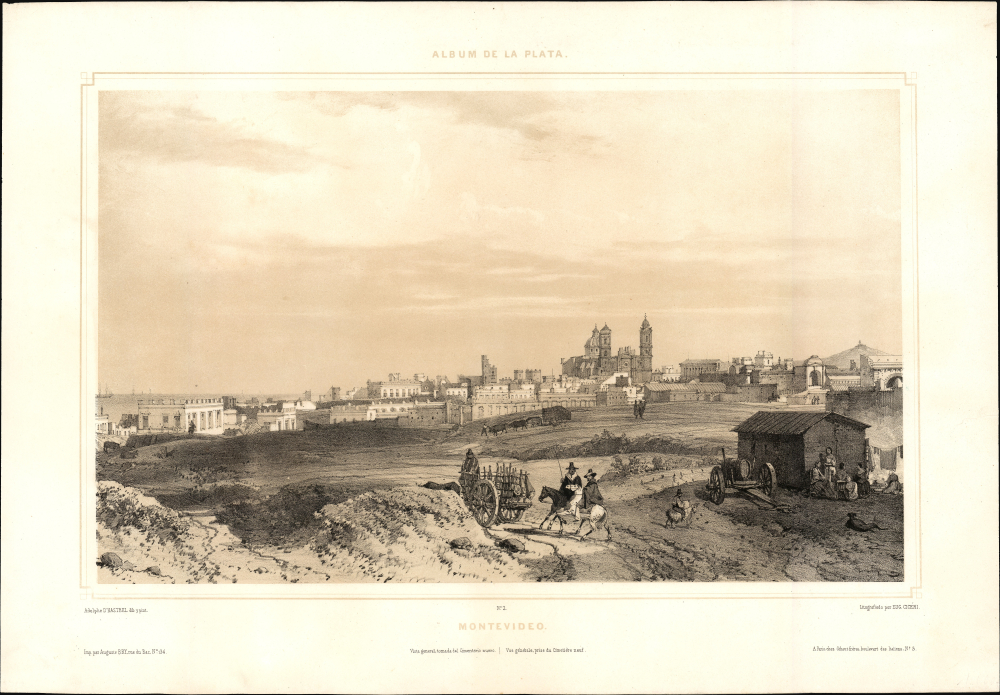This item has been sold, but you can get on the Waitlist to be notified if another example becomes available, or purchase a digital scan.
1846 d'Hastrel Panoramic View of Montevideo
Montevideo-hastrel-1846
Title
1846 (undated) 12 x 16.75 in (30.48 x 42.545 cm)
Description
A Closer Look
The view presents a panorama of Montevideo's Ciudad Vieja, viewed from the east. Prominent in the view is the Catedral Metropolitana. In the distant background, ships can be seen in the harbor. In the foreground, Uruguayans are illustrated on foot and on horseback - indeed, one appears to be riding a ram. An ox-cart carrying butchered cuts of meat rolls towards the city. In the middle ground, a cart drawn by six oxen carries a heavy load - perhaps material for the city fortifications. To the right, a group of women sit in the shade of a simple hovel, perhaps a laundry or a dyers. We can see another woman laboring at a fire under cloth drying on a line. Such scenes are characteristic of d'Hastrel, who had an eye for daily life.The Great Siege of Montevideo
The newly independent nation of Uruguay was wracked by civil war from 1830 to 1851. Opposing presidents, Fructuoso Rivera and Manuel Oribe, formed opposing political parties: the Colorados and the Nationals, respectively. Oribe's Nationals, wearing white armbands, came to be known as Blancos. Rivera's, with red armbands, were dubbed Colorados. Following the defeat of the Colorados at the battle of Arroyo Grande, the Blancos moved to swiftly take Montevideo. The Colorado defense of the city had substantial support from a large community of foreign exiles (including not only the French but also the famous Italian revolutionary Giuseppe Maria Garibaldi) and a contingent of 5,000 free slaves. This defense forced a 9-year siege. It ended when the British navy opened a supply line for Montevideo, effectively breaking the siege.Publication History and Census
This lithograph was prepared in 1846 in Paris by Étienne Eugène Cicéri for publication in d'Hastrel's Album de la Plata, published by chez Gihaut. The Album is rare: we see only one institutional example at the Bibliothèque National de France. We see a sole example of the separate view in the same institution.CartographerS
Adolphe Hastrel de Rivedoux (Adolphe d'Hastrel; October 4, 1804 - July 1, 1875) was a French artist, writer, and traveler who became known for his landscapes - particularly those of the Americas. Wastrel was born in Neuwiller-lès-Saverne, Bas-Rhin, France, to a military family. He became a talented watercolorist, but ultimately followed his family vocation and joined the French navy as an artillery officer. His more than twenty years of travel with the navy allowed him to produce a rich corpus of watercolor landscapes from around the world firsthand. His works included portraits of natives in their traditional costumes, images of daily life, and city panoramas. He produced some lithographs on his own and was also an early adopter of photography, including daguerreotypes. He died in 1875 in Nantes, Loire-Atlantique, France. More by this mapmaker...
Étienne Eugène Cicéri (January 27, 1813 - April 20, 1890) was a French painter, illustrator, engraver, and theater designer active in the middle part of the 19th century. Cicéri was born in Paris, the son and pupil of the painter and scenographer Pierre-Luc-Charles Cicéri (1782 - 1868). His instruction. In art began as a child under his father and uncle, Eugène Isabey (1803 - 1886). Influence by the Barbizon School of landscape art, he rose to prominence as a landscape pater and watercolorist, working at Fontainebleau, the Alps, and the Pyrenees. He exhibited at the Paris Salon for the first time in 1851 continued to exhibit until at least 1886. He also issued North African landscapes and painted scenes to illustrate the travels of Jules Sébastien César Dumont d'Urville's (1790 - 1842) circumnavigation - all of which earned him a place among the orientalists. Learn More...

